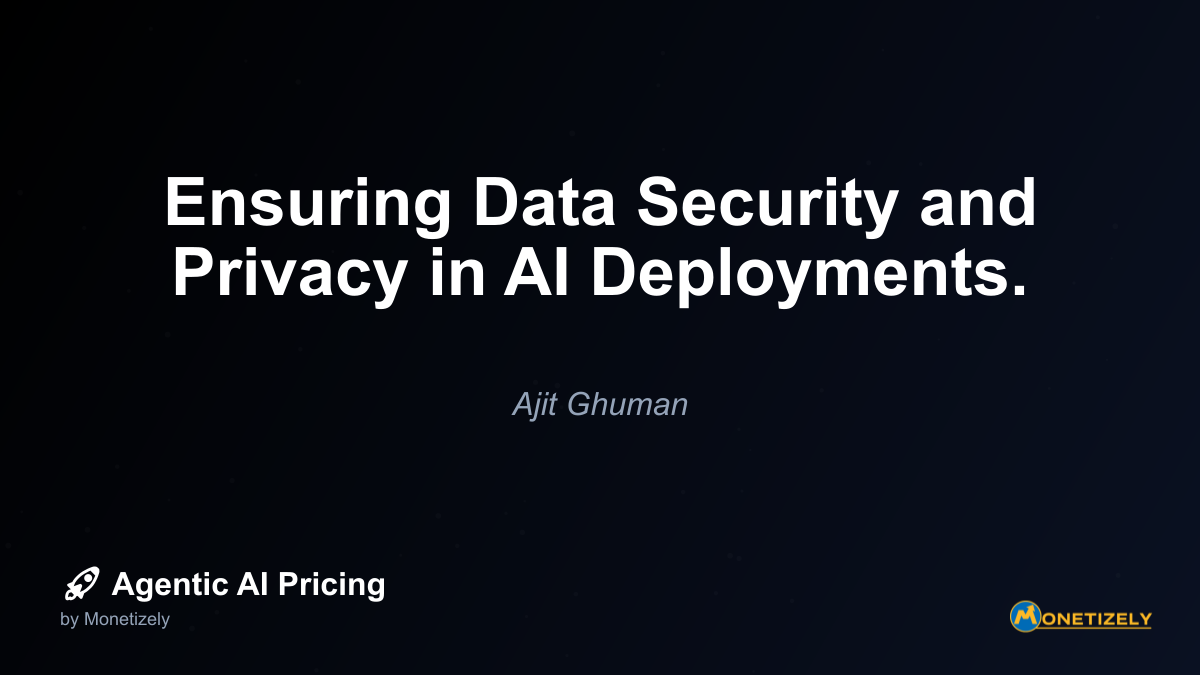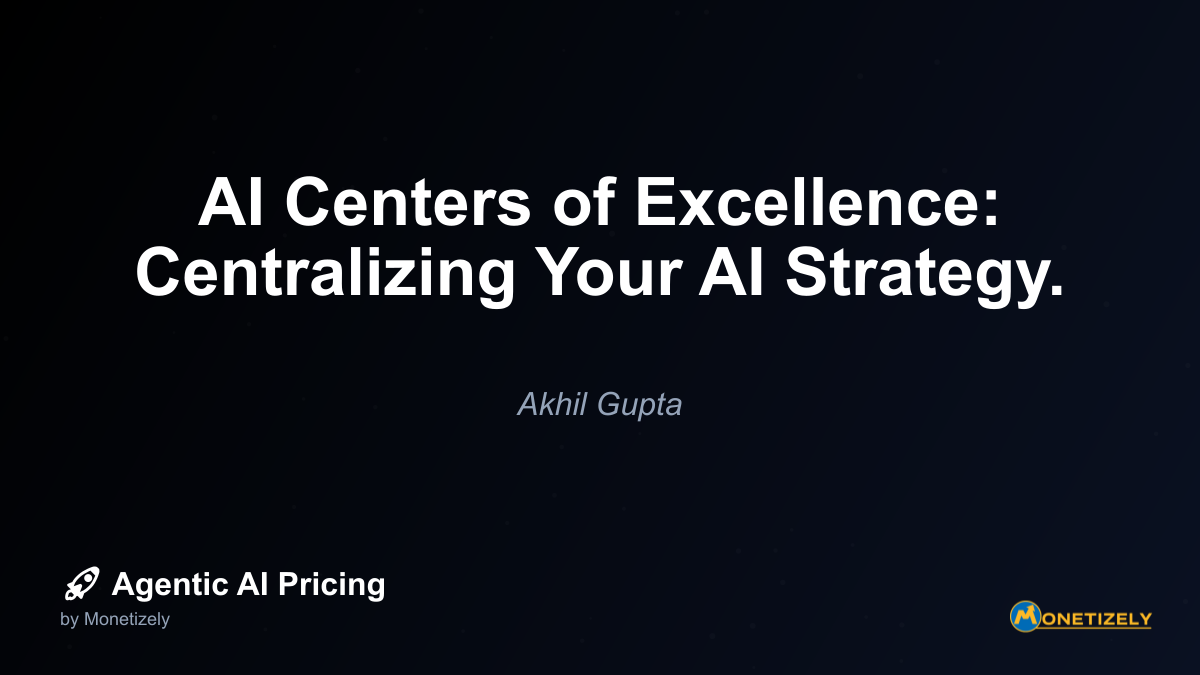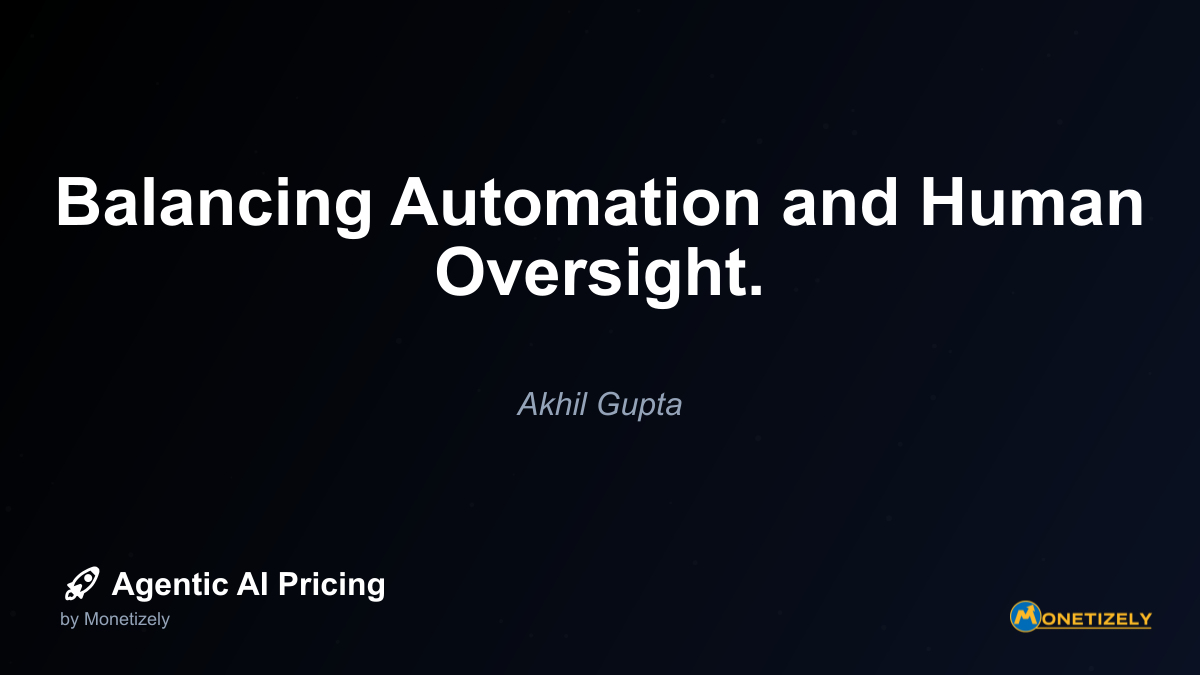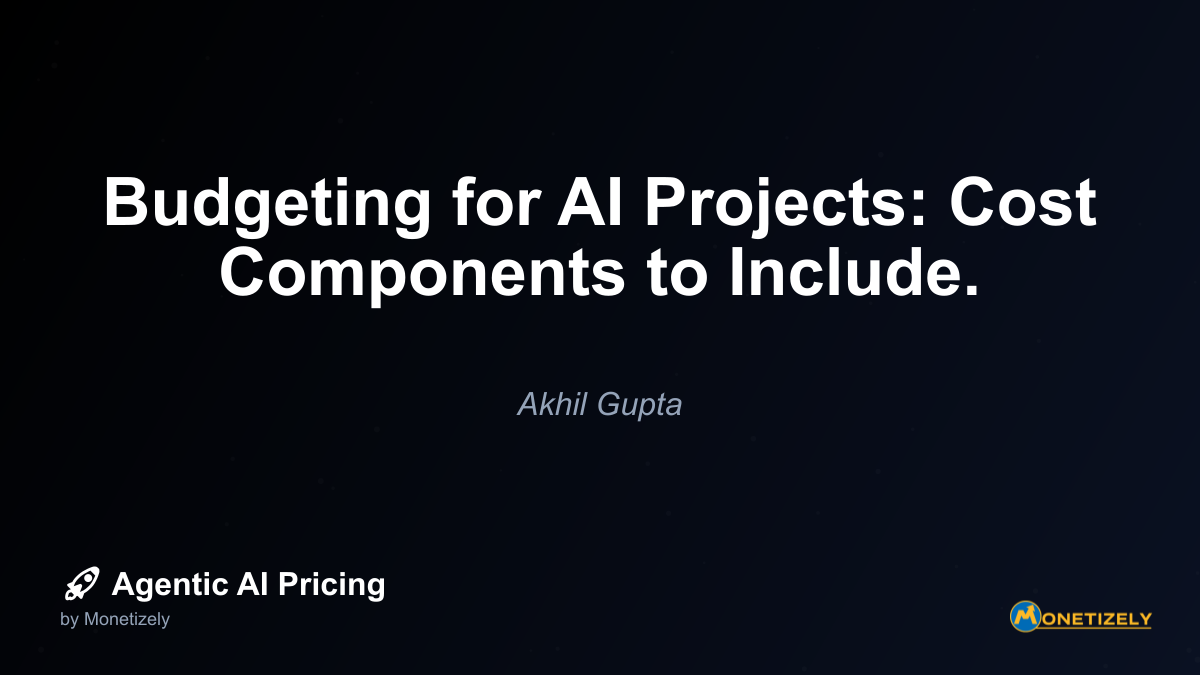· Akhil Gupta · Implementation Strategies · 9 min read
Cloud vs. On-Prem Deployment: Impact on AI Solution Costs.
AI and SaaS Pricing Masterclass
Learn the art of strategic pricing directly from industry experts. Our comprehensive course provides frameworks and methodologies for optimizing your pricing strategy in the evolving AI landscape. Earn a professional certification that can be imported directly to your LinkedIn profile.
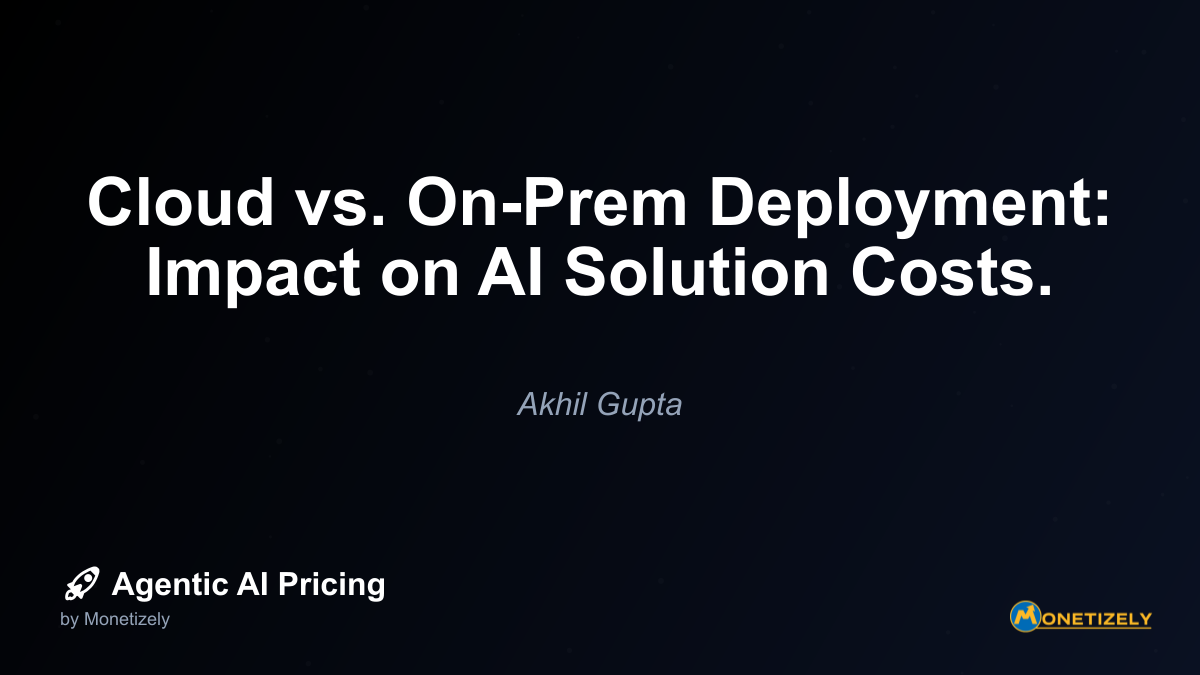
Cloud computing has revolutionized how organizations deploy and manage their technology infrastructure, particularly for artificial intelligence solutions. As AI becomes increasingly central to business operations, decision-makers face a critical choice: deploy AI solutions in the cloud or maintain them on-premises? This decision carries significant implications for cost structures, scalability, maintenance requirements, and regulatory compliance.
Understanding Cloud vs. On-Premises AI Deployments
Before diving into cost implications, let’s clarify what these deployment models entail. Cloud-based AI solutions leverage third-party infrastructure, typically offered by major providers like AWS, Google Cloud, or Microsoft Azure. These providers host the computing resources, storage, and often the AI services themselves. On-premises (on-prem) deployment, conversely, involves installing and running AI solutions on hardware physically located within an organization’s facilities.
The fundamental difference lies in who owns, manages, and maintains the infrastructure. With cloud solutions, the provider handles most infrastructure concerns, while on-prem deployments place this responsibility squarely on the organization’s shoulders.
Cost Structure Differences: OpEx vs. CapEx
One of the most significant distinctions between cloud and on-prem AI deployments is their cost structure. Cloud solutions typically follow an operational expenditure (OpEx) model, while on-prem deployments generally require capital expenditure (CapEx).
Cloud Deployment: The Subscription Economy
Cloud-based AI solutions usually operate on subscription pricing models with the following characteristics:
- Predictable recurring costs: Monthly or annual fees based on usage or service tiers
- Minimal upfront investment: Little to no initial capital required
- Usage-based scaling: Costs that increase or decrease with consumption
- Bundled services: Infrastructure, maintenance, and updates included in subscription fees
- Resource elasticity: Ability to scale up or down as needed
For example, an organization using a cloud-based natural language processing service might pay $0.001 per API call or $5,000 monthly for a certain volume of processing. This predictability helps with budgeting but can lead to “subscription fatigue” as costs accumulate over time.
On-Premises Deployment: The Investment Approach
On-prem AI deployments follow a more traditional investment model:
- Significant upfront costs: Hardware purchases, infrastructure setup, software licensing
- Depreciation benefits: Capital expenses can be depreciated over time for tax advantages
- Ongoing maintenance costs: Hardware replacement, upgrades, and IT personnel
- Fixed capacity: Resources limited by purchased hardware
- Long-term cost advantages: Potentially lower total cost of ownership (TCO) for stable, long-term workloads
An organization deploying AI models on-premises might invest $250,000 in specialized hardware, plus ongoing costs for power, cooling, maintenance, and personnel. While this represents a substantial initial investment, it could prove more economical for consistent, high-volume AI workloads over a 3-5 year period.
Hidden Cost Factors in AI Deployments
Beyond the obvious subscription fees and hardware costs, several hidden factors significantly impact the total cost of AI deployments.
Staffing and Expertise Requirements
Cloud and on-prem deployments demand different levels of internal expertise:
Cloud AI Solutions:
- Require less infrastructure expertise
- Focus on integration and application development
- May need cloud cost management specialists
- Lower overall IT staffing requirements
On-Premises AI Solutions:
- Demand specialized hardware knowledge
- Require dedicated IT staff for maintenance
- Need security and compliance experts
- Often require larger, more specialized teams
The salary differences between these staffing models can be substantial. A mid-sized enterprise might spend an additional $300,000-$500,000 annually on specialized personnel for on-prem AI infrastructure that wouldn’t be necessary with cloud deployments.
Scalability Economics
How costs scale with usage differs dramatically between deployment models:
Cloud Scalability:
- Near-infinite capacity on demand
- Costs scale linearly with usage
- No wasted capacity during low-usage periods
- Ability to experiment with minimal commitment
- Rapid deployment of new capabilities
On-Premises Scalability:
- Capacity limited by purchased hardware
- Step-function cost increases (buying new servers)
- Unused capacity during low-demand periods
- Higher cost of experimentation
- Longer lead times for expansion
This scalability difference creates interesting economic dynamics. Cloud solutions may cost more during steady-state operations but avoid the “capacity planning tax” of overprovisioning that on-prem deployments often incur to handle peak loads or future growth.
Performance and Throughput Considerations
AI workloads have unique performance characteristics that affect deployment economics:
Data Transfer Costs
The movement of data significantly impacts AI deployment costs:
Cloud Considerations:
- Data ingress often free, egress expensive ($0.05-$0.15/GB)
- API call volumes can accumulate significant costs
- Network bandwidth requirements for real-time applications
- Potential latency issues for time-sensitive AI applications
On-Premises Considerations:
- No data transfer fees between local systems
- Lower latency for data-intensive operations
- Higher costs for external data integration
- Fixed network infrastructure costs
Organizations processing terabytes of data daily through AI systems can face cloud data transfer costs exceeding $10,000 monthly, making on-prem solutions potentially more economical despite higher initial investment.
Specialized Hardware Optimization
AI workloads often benefit from specialized hardware:
Cloud Provider Advantages:
- Access to latest GPUs, TPUs, and AI accelerators
- Pay-per-use for expensive specialized hardware
- Automatic hardware upgrades
- Optimized environments for common AI frameworks
On-Premises Advantages:
- Hardware customization for specific workloads
- Consistent performance without multi-tenancy issues
- Better utilization of specialized hardware for continuous workloads
- Longer hardware lifecycle management
The economics here depend heavily on utilization. Cloud GPU instances might cost $2-$25 per hour, making them ideal for sporadic AI training. However, organizations running AI inference continuously might find a $50,000 on-prem GPU server more economical over a 3-year period.
Maintenance and Operational Considerations
The ongoing costs of keeping AI systems operational vary significantly between deployment models:
Software Updates and Model Management
Cloud AI Platforms:
- Automatic updates and security patches
- Managed model versioning
- Simplified A/B testing infrastructure
- Provider-managed framework compatibility
On-Premises AI Platforms:
- Manual update processes
- Internal model version control systems
- Custom testing infrastructure requirements
- Framework compatibility management
These differences translate to operational costs. Cloud solutions might include these capabilities in their subscription fees, while on-prem deployments require dedicated personnel time, potentially adding $100,000+ annually in operational overhead for enterprise deployments.
Reliability and Redundancy Costs
Ensuring system availability carries different cost implications:
Cloud Redundancy:
- Geographic redundancy included or available as add-on
- Disaster recovery capabilities built into service
- Uptime guarantees via SLAs
- Provider-managed failover systems
On-Premises Redundancy:
- Requires duplicate hardware investments
- Manual disaster recovery processes
- Self-managed uptime assurance
- Custom failover implementation
Building redundant on-prem AI infrastructure can double hardware costs and significantly increase operational complexity. Cloud solutions typically build redundancy into their pricing models, offering economies of scale that individual organizations cannot match.
Compliance and Security Considerations
Regulatory requirements add another dimension to the cost equation:
Data Sovereignty and Regulatory Compliance
Cloud Compliance Factors:
- Regional data centers for geographic compliance
- Shared compliance certifications (SOC 2, HIPAA, etc.)
- Limited control over physical security
- Provider-managed compliance updates
On-Premises Compliance Factors:
- Complete control over data location
- Custom compliance implementations
- Direct physical security oversight
- Self-managed compliance updates
For organizations in highly regulated industries like healthcare or finance, compliance requirements may dictate deployment choices regardless of other cost factors. The cost of non-compliance (potential fines, business impact) often outweighs infrastructure considerations.
Security Implementation Costs
Securing AI systems requires different approaches based on deployment:
Cloud Security Costs:
- Shared security responsibility model
- Security features bundled with services
- Specialized cloud security tools and monitoring
- Provider vulnerability management
On-Premises Security Costs:
- Complete security responsibility
- Dedicated security infrastructure
- Internal security monitoring systems
- Self-managed vulnerability response
Organizations typically spend 10-15% of their IT budget on security. This percentage often increases for AI systems handling sensitive data, with on-prem deployments generally requiring higher security investments than their cloud counterparts.
Hybrid Approaches: The Best of Both Worlds?
Many organizations are finding that hybrid deployment models offer optimal economics for AI workloads:
Strategic Workload Placement
A nuanced approach places AI workloads based on their economic and operational characteristics:
- Training models in the cloud, deployment on-premises
- Sensitive data processing on-prem, general processing in cloud
- Burst capacity in cloud, baseline capacity on-premises
- Development in cloud, production on-premises
This selective approach can optimize costs by leveraging the strengths of each model. For example, an organization might use cloud resources for computationally intensive but intermittent model training while deploying the resulting models on-premises for continuous inference operations.
Cost Optimization Strategies for Hybrid Deployments
Effective hybrid deployments require careful cost management:
- Reserved instances for predictable cloud workloads
- Spot instances for interruptible AI training jobs
- Hardware lifecycle management for on-prem components
- Data locality planning to minimize transfer costs
- Containerization for workload portability
A well-architected hybrid approach can reduce AI infrastructure costs by 30-40% compared to pure cloud or pure on-premises solutions for complex enterprise deployments.
Making the Decision: A Framework for Evaluation
When evaluating cloud versus on-premises AI deployments, organizations should consider:
Time Horizon Considerations
The length of deployment significantly impacts economic calculations:
- Short-term projects (6-18 months): Cloud typically more economical
- Medium-term deployments (2-3 years): Detailed TCO analysis required
- Long-term infrastructure (4+ years): On-prem often advantageous
- Uncertain duration: Cloud provides flexibility advantage
The crossover point where on-premises becomes more economical typically occurs between 24-36 months for stable, high-utilization AI workloads.
Workload Predictability Assessment
The predictability of AI processing requirements affects optimal deployment:
- Highly variable workloads: Cloud elasticity provides economic advantages
- Steady-state processing: On-premises can offer lower long-term costs
- Seasonal variations: Hybrid approaches may optimize economics
- Growth uncertainty: Cloud reduces overprovisioning risk
Organizations should analyze their AI workload patterns over multiple time horizons to identify the most cost-effective deployment strategy.
Total Cost of Ownership Calculation
A comprehensive TCO analysis should include:
- Direct infrastructure costs (hardware/subscription fees)
- Personnel requirements (implementation, maintenance, security)
- Data transfer and storage expenses
- Training and expertise development
- Compliance and security implementation
- Opportunity cost of deployment time
- Business continuity and disaster recovery
This analysis often reveals that the initial cost advantage of one deployment model may be offset by hidden expenses in another area.
Real-World Cost Comparison Example
To illustrate these concepts, consider a mid-sized enterprise implementing a computer vision AI system for quality control:
Scenario Parameters
- 24/7 operation analyzing production line images
- 500,000 images processed daily
- 5TB monthly data generation
- 3-year planning horizon
- Regulatory requirements for data retention
Cloud Deployment Costs (3-Year)
- API processing: $0.001/image × 500,000 daily = $15,000/month
- Data storage: $0.02/GB × 5TB monthly = $100/month + cumulative storage
- Data egress: $0.08/GB × 2TB monthly = $160/month
- Cloud security and compliance tools: $2,000/month
- Integration development: $150,000 one-time
- Cloud management personnel: $120,000 annually
Estimated 3-Year TCO: $920,000
On-Premises Deployment Costs (3-Year)
- AI server hardware: $200,000 initial
- Storage infrastructure: $75,000 initial
- Networking equipment: $30,000 initial
- Software licensing: $100,000 initial + $25,000 annually
- Power and cooling: $3,000 monthly
- IT personnel (partial allocation): $200,000 annually
- Security implementation: $50,000 initial + $20,000 annually
Estimated 3-Year TCO: $1,105,000
In this scenario, cloud deployment offers approximately 17% cost advantage over three years, primarily due to personnel cost differences and the ability to avoid large capital expenditures. However, extending the analysis to 5 years might shift the advantage to on-premises deployment as the initial capital investments are amortized over a longer period.
Conclusion: Making the Right Choice for Your AI Initiatives
The decision between cloud and on-premises AI deployments involves balancing numerous factors beyond simple subscription costs versus hardware investments. Organizations must consider their unique circumstances:
- Financial priorities: OpEx versus CapEx preferences
- Technical expertise: Internal capabilities and staffing
- Data characteristics: Volume, sensitivity, and locality requirements
- Workload patterns: Variability, predictability, and growth
- Compliance landscape: Regulatory requirements and risk tolerance
Most importantly, organizations should recognize that this isn’t necessarily an either/or decision. Many successful AI implementations leverage both deployment models strategically, placing workloads where they make the most economic and operational sense.
As AI becomes increasingly central to business operations, thoughtful deployment decisions that consider both immediate costs and long-term economics will provide significant competitive advantages. By understanding the full cost implications of cloud versus on-premises AI deployments, organizations can build infrastructure strategies that support their AI ambitions while optimizing their technology investments.
The most successful organizations will continue to evaluate these tradeoffs as both their AI needs and the technology landscape evolve, maintaining flexibility to adapt their deployment strategies accordingly.
Co-Founder & COO
Akhil is an Engineering leader with over 16+ years of experience in building, managing and scaling web-scale, high throughput enterprise applications and teams. He has worked with and led technology teams at FabAlley, BuildSupply and Healthians. He is a graduate from Delhi College of Engineering and UC Berkeley certified CTO.
Pricing Strategy Audit
Let our experts analyze your current pricing strategy and identify opportunities for improvement. Our data-driven assessment will help you unlock untapped revenue potential and optimize your AI pricing approach.

